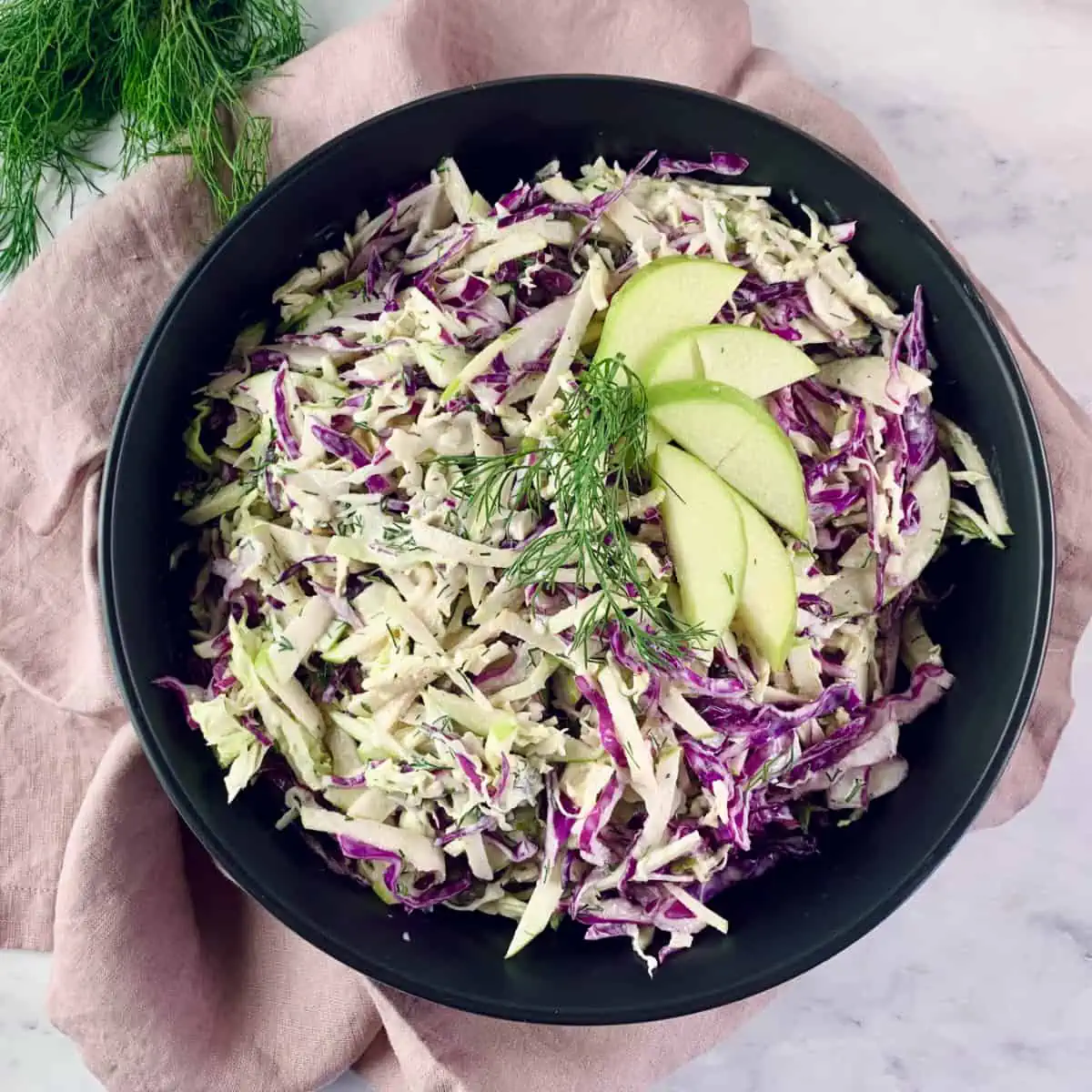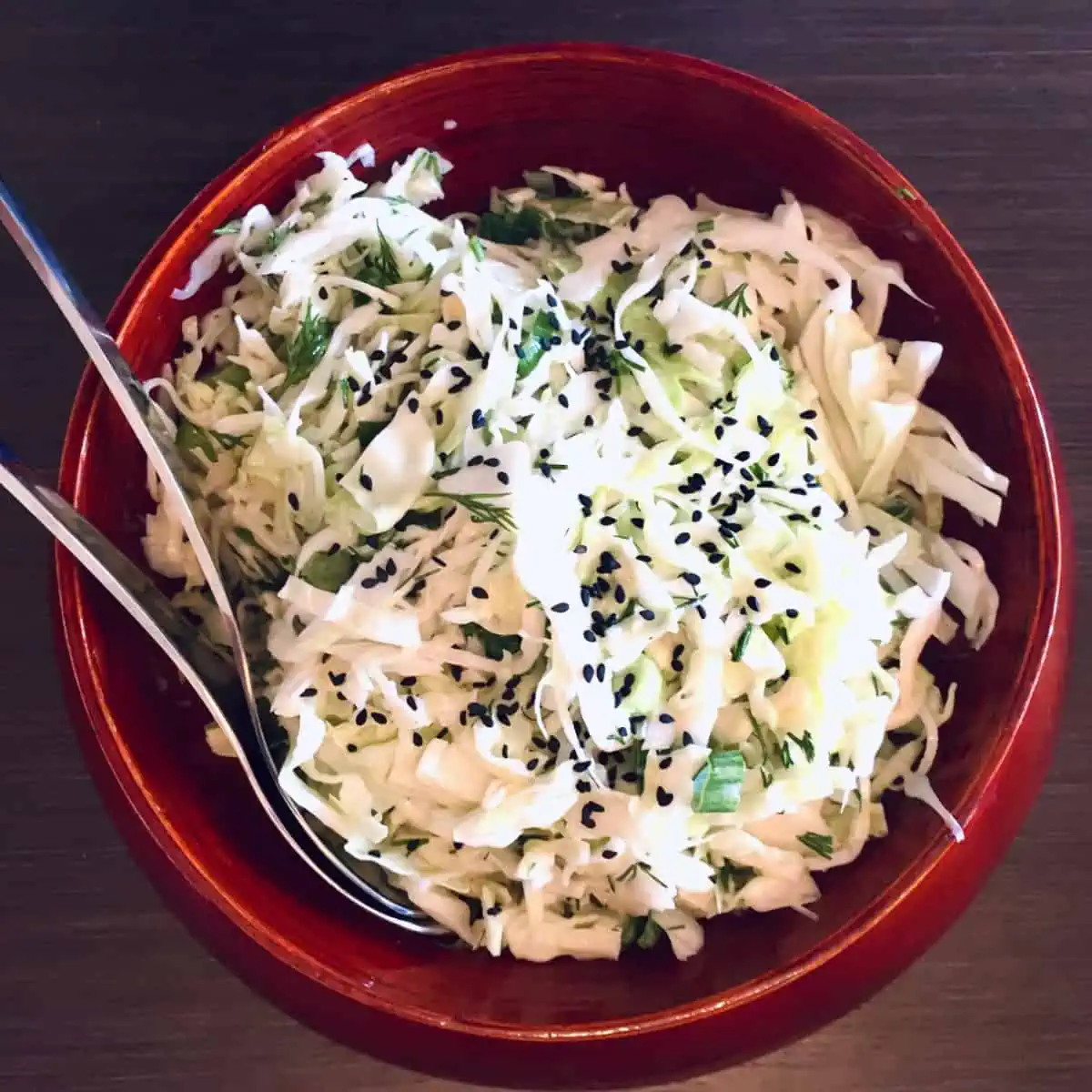Looking to perfect your slaw making? Well, you're in luck because today we're diving into the art of how to cut cabbage for slaw. So grab your chopping board and let's get started!

Our Quick Guide to Cutting Cabbage
- Grab Your Equipment: get out a cutting board, your sharp chef knife, mandolineor food processor before we start.
- Wash and Trim: remove any wilted or tough outer leaves and wash it thoroughly.
- Cut into Wedges: place the cabbage on the cutting board and cut it in half through the stem.
Then, turn each of these halves onto their flat sides for easier handling as we further divide them into quarters – giving us four equal parts! - Remove the Core: flip those quarters over so they're resting on their curved sides. We'll want to carefully trim out the core since it can be quite tough to eat.
- Shred Cabbage: Lay those quarter wedges down flat on your so you can easily slice them into thin strips for your slaw. Or shred using your mandoline or with a food processor.
- Long or Short Strips: for longer strips, make lengthwise cuts; if shorter is more your style - then widthwise slices are what you’re after!
Preparing Cabbage by Type
Cutting cabbage for slaw is a straightforward process, adaptable to personal preferences, cabbage varieties, and the tools available in your kitchen. Read more about the different types in our cabbage varieties post.
Preparing Long Cabbage Varieties
This cutting method is perfect for Pointed Cabbage (also known as Conehead) and Napa Cabbage (also called Wombok or Chinese Cabbage). Let's dive in!
To start, let's get rid of its hard core and those unsightly wilted, discoloured, and thick outer leaves.

Once that's done, cut the cabbage head lengthwise in half, carefully pulling apart the leaves for your wombok and giving them a good rinse in the sink with cold water

Make sure to pat them dry afterwards to get rid of any excess water.

Finally, it's time to thinly shred your cabbage.

Preparing Round Cabbage Varieties
Use it for white/green cabbage, red cabbage, savoy cabbage, January king cabbage, etc.
Firstly, remove any wilted, discoloured, or thicker outer leaves from the cabbage and the cut it into wedges. Rinse these wedges under cold running water.
If you find any signs of worms or insects after cutting open the cabbage, simply soak it in salt water for 20 minutes to get rid of those pests.
Next, cut out the hard core from each cabbage wedge.

Cutting Techniques for Slaws
Before beginning our journey of slaw prep, let’s explore essential cutting techniques for that perfect slaw consistency.
- Firstly, knife cutting techniques provide the finesse and precision needed to craft the foundational elements of your slaw.
- Next, wielding a mandoline for cabbage ensures impeccable consistency, ideal for those craving uniformity in texture.
- Lastly, a food processor for cabbage becomes your trusty companion, swiftly transforming it into evenly chopped morsels that eagerly absorb the dressing.
1. The Knife Method
After we have prepped our cabbage, so get out a sharp knife and we can start.
- Take a wedge of cabbage and place it face down on your chopping board making sure that you are holding it steady.
- Then using a sharp knife, slice with confidence, aiming for thin, even cuts that are crucial for that perfect slaw consistency.
- Safety first: Keep your fingers safely tucked away and feel free to rotate the cabbage as needed for stability.
- For long shreds slice carefully along the vertical edge; for short shreds slice along the horizontal edge.
- Continue until you have your desired amount of cabbage.

2. With A Mandoline/Vegetable Slicer
The mandoline/v-slicer is my preferred method to slice cabbage as it gives me shreds that are thinner and even without the hassle of having to get out my food processor.
- First things first, set up your mandoline or vegetable slicer as per the manufacturer's instructions.
- Once that's done, take your cabbage wedge and carefully place it on the slicing surface of your mandoline.
- Now for the fun part – gently slide the cabbage back and forth across the blade with a steady motion to get those perfect uniform slices.
- Remember to use caution and always make sure to use that safety guard; we don't want any accidents!
- Keep at it until you've sliced up enough of that lovely cabbage to make your slaw.

3. Employing a Food Processor
For large slaw batches, I get out my food processor as it makes cabbage cutting a breeze.
- We set up this culinary ace with either the flat blade for longer shreds or the grating blade for shorter shreds.
- Then we cut our wedges into slices that will fit the chute/feed tube of your food processor. Make sure not to cut horizontally as this will disconnect the leaves.
- Then feed each wedge into the feed tube using the pusher, emptying the bowl when it is full. Continue until you have all the lovely thin cabbage slices you need for your slaw.

Washing Your Cabbage
While it is important to rinse your cabbage before you start shredding, I also like to give it a good rinse once it has been sliced to make sure that there are no nasties lurking in the tight leaves.
- Just pop your shredded cabbage in a colander in the sink and thoroughly rinse it under cold running water.
- Then strain well, and then tap the edge of the colander on the sink to shake out the excess water.
- You can either spin it or pat it dry if you want 100% dry cabbage slices.

Massaging Cabbage
Why massage your cabbage?
Massaging cabbage for slaw helps to break down its fibres, resulting in a more tender texture and allowing it to better absorb the flavours of the dressing.
Pop it in a colander over the sink then add a sprinkle of salt.

Massage it for a few minutes for a softer texture, there is no need to rinse the salt, as this will season the salad.

Safety First: Tips for Cabbage Cutting
- Always keep fingers away from blades while slicing.
- Use a guard with mandolines or v-slicers.
- Secure the cutting board to prevent slips.
- Wear cut-resistant gloves for extra protection.
Common Questions
How far ahead can I cut cabbage for slaw?
- You can cut cabbage for slaw a few hours in advance.
- If you need to prepare it ahead of time, store the sliced cabbage in an airtight container in the refrigerator until you're ready to use it.
- To keep it for a week place your cabbage in an airtight container and cover it with water. It should keep in the fridge for a week or more, just make sure you rinse it well before using because it will be a bit smelly.
Can I mix different types of cabbage for slaw?
bsolutely! Mixing different types of cabbage, such as green cabbage, red cabbage, and Chinese/Napa cabbage, can add a variety of flavours and textures to your slaw. Just be sure to adjust the seasoning and dressing accordingly to complement the different cabbage varieties.
Do I need any special equipment to cut cabbage for slaw?
While a sharp chef knife is ideal, you don't necessarily need any special equipment. However, a mandoline or food processor can make the slicing process quicker and more uniform.
What can I do with leftover cabbage after making slaw?
Leftover cabbage can be used in stir-fries, soups, salads, or even fermented into sauerkraut. Alternatively, you can freeze it for later use in cooked dishes.
Ready, Set, Slaw! Exploring Our Favorite Recipes
With our cabbage masterfully prepped, we're thrilled to unveil our beloved slaw recipes, inviting you to explore and create your perfect slaw marvel.

















Leave a Reply